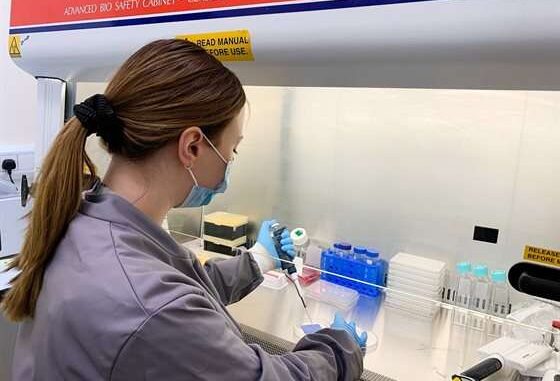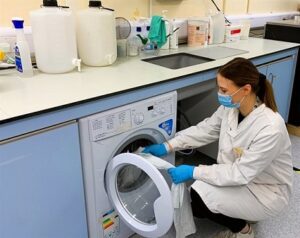
Views: 6
– Viruses similar to the strain that causes Covid-19 can survive on clothing and spread to other surfaces for up to 72 hours, warned scientists at De Montfort University Leicester (DMU).
Minapim by Hernan Valenzuela: In a study looking at how the coronavirus behaves in three tissues commonly used in the healthcare industry, the researchers found that the traces can remain infectious for up to three days.
Led by microbiologist Dr. Katie Laird, virologist Dr. Maitreyi Shivkumar and postdoctoral researcher Lucy Owen, the research involved adding droplets of a coronavirus model called HCoV-OC43 – which has a very survival structure and pattern similar to those of SARS-CoV-2, which makes Covid-19 – for polyester, polycotton and 100% cotton.
The scientists then monitored the stability of the virus in each material for 72 hours.
The risks
The results showed that polyester represents the greatest risk of transmission of the virus, with the infectious virus still present after three days that can transfer to other surfaces. In 100% cotton, the virus lasted 24 hours, while in polycotton, the virus survived only six hours.
“When the pandemic started, there was very little understanding of how long the coronavirus could survive in tissues,” said Dr. Katie Laird, head of the DMU’s Infectious Disease Research Group.
“Our findings show that three of the tissues most commonly used in healthcare are at risk of transmitting the virus. If nurses and healthcare professionals take their uniforms home, they may be leaving traces of the virus on other surfaces. “
Misguided orientation
Last year, in response to the pandemic, Public Health England (PHE) issued a guideline stating that industrial washing should be used for uniforms for healthcare professionals, but where this is not possible, employees should take uniforms home to be washed .
Meanwhile, the NHS uniform and the work clothing guidelines state that it is safe to wash healthcare workers’ uniforms at home, provided the temperature is at least 60 ° C.
Dr. Laird raised concerns that the evidence supporting the statements above was based mainly on two outdated literature reviews published in 2007.
In response, she advised the government that all health uniforms should be washed in hospitals in accordance with commercial standards or in an industrial laundry.
Since then, she has co-published an updated and fully comprehensive literature review that assesses the risk of textiles in disease transmission, highlighting the need for infection control procedures when handling contaminated health textiles.
“After reviewing the literature, the next step in our work was to assess the risk of infection control by washing health uniforms contaminated with coronavirus,” she continued. “After determining the coronavirus survival rate in each of the tissues, we turned our attention to identifying the most reliable washing method to remove the virus.”
The washing
Using 100% cotton, the most commonly used health fabric, scientists conducted a series of tests using different water temperatures and washing methods, including household washing machines, industrial machines, on-site hospital washing machines and an ozone (a highly reactive product gas) washing system.

The results showed that the effect of agitation and dilution of water in all the washers tested was sufficient to remove the virus.
However, when the team soiled the tissues with artificial saliva containing the virus (to mimic the risk of spreading an infected person’s mouth), they found that domestic washing machines did not completely remove the virus and some traces survived.
It was only when they added detergent and increased the water temperature that the virus was completely eliminated. Investigating the virus’s tolerance to heat alone, the results showed that the coronavirus was stable in water up to 60 ° C, but was inactivated at 67 ° C.
Clothing spreading virus
The team then assessed the risk of cross-contamination by placing clean items of clothing in the same wash as those with traces of the virus. They found that all washing systems removed the virus and there was no risk of contamination from the other items.
Dr. Laird explained: “Although we can see from research that washing these materials at a high temperature, even in a domestic washing machine, removes the virus, does not eliminate the risk that contaminated clothing will leave traces of coronavirus on other surfaces in the home or in the car before they are washed.
“Now we know that the virus can survive for up to 72 hours in some tissues and that it can also transfer to other surfaces.
“The research reinforced my recommendation that all health uniforms should be washed on the spot, in hospitals or in an industrial laundry. These washing methods are regulated and nurses and health professionals do not have to worry about taking the virus home ”.
Source: De Montfort University Leicester (DMU)
Related article: Stanford – Computer model that predict how COVID-19 infections spreads